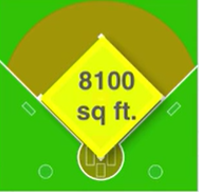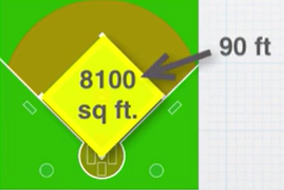The square root of a number is an operation or calculation that is performed on a number, resulting in a number whose product with itself is the original number.
EXAMPLE
The square root of 9 is 3, because 3 times 3 is 9.
EXAMPLE
As you can see in the examples below, 7 squared is 49, and the square root of 49 is 7. Therefore, 49 is a perfect square. Similarly, 2 squared is 4, and the square root of 4 equals 2. So, 4 is a perfect square. Lastly, 5 squared equals 25, and the square root of 25 equals 5; 25 is also a perfect square.



To simplify square roots, you can find factors of the number inside the square root and break the expression into several square roots using the product property of roots.
In general, the product property of roots says that the square root of a times b is equivalent to the square root of a times the square root of b.

EXAMPLE
10 squared equals 100; therefore, you can see that the square root of 100 equals 10. However, you can also determine this by using the product property of roots. The square root of 100 is equal to the square root of 4 times 25, so using the product property of roots, you know this is equal to square root of 4 times the square root of 25. This, in turn, is equal to 2 times 5, which equals 10.


EXAMPLE
The square root of 4 plus 9 is equal to the square root of 13, which is approximately 3.606. However, the square root of 4 plus the square root of 9 is equal to 2 plus 3, which is equal to 5. Therefore, you can see that there is no addition property of roots.


IN CONTEXT
Suppose the baseball diamond in a stadium has an area of 8,100 square feet. Since all the sides of the diamond have equal length, the area of the diamond can be represented with the formula A is equal to s squared, where s is the side length.


Since you know that the area is 8,100, you can plug this number into the formula, so that 8,100 equals s squared.

Next, to find the length of each side of the diamond, or the distance between each base, you can take the square root of each side of the equation, giving you the equation of the square root of 8,100 is equal to s.

Now you can simplify using the product property of roots. The square root of 8,100 is equal to the square root of 81 times 100. This, in turn, is equal to the square root of 81 times the square root of 100, which equals 9 times 10, or 90 feet.

Therefore, the side length, or the distance between bases in the baseball diamond, is approximately 90 feet.

You can also simplify square roots using the order of operations, which is illustrated by the acronym PEMDAS to help you remember the correct order of operations. PEMDAS stands for:
Parentheses (and other grouping symbols)
Exponents
Multiplication
Division
Addition
Subtraction
Square roots and other radicals fall under the parentheses, since a square root acts as a grouping symbol when there are other operations underneath the square root. This means that the operations underneath the radical must be performed before taking the root.

|
|
Our expression |

|
|
Because the radical acts as a grouping symbol, we need to evaluate everything under it before we take the root. So we will start with the exponent. 4 squared equals 16. |

|
|
Next, we will multiply 12 and 3. This gives us 36. |

|
|
Now, we can add 36 and 16, which gives us 52. |

|
|
Now, we can simplify the square root. The square root of 52 can be written as the square root of 4 times 13, which is the same as the square root of 4 times the square root of 13 |

|
|
We can simplify the square root of 4 to be 2 times the square root of 13. Make sure that the square root of 13 is placed at the end of the expression. |

|
|
Our solution |
IN CONTEXT
Suppose you are on a vacation, traveling to a landmark that is 2 miles east and 4 miles south of your hotel. What is the straight line distance between your hotel and the landmark? You can use the Pythagorean theorem to determine this straight line distance.
The straight line distance, d, will be equal to the square root of 2 squared plus 4 squared.
You can start to simplify by evaluating your exponents and squaring 2 and 4. This gives you the square root of 4 plus 16. The square root of 4 plus 16 is the square root of 20, which can be written as the square root of 4 times 5. This is equivalent to the square root of 4 times the square root of 5, which is equal to 2 times the square root of 5.
Again, you would place the square root of 5 at the end of the expression. Therefore, the straight line distance between your hotel and the landmark is 2 times the square root of 5 miles.
Source: This work is adapted from Sophia author Colleen Atakpu.